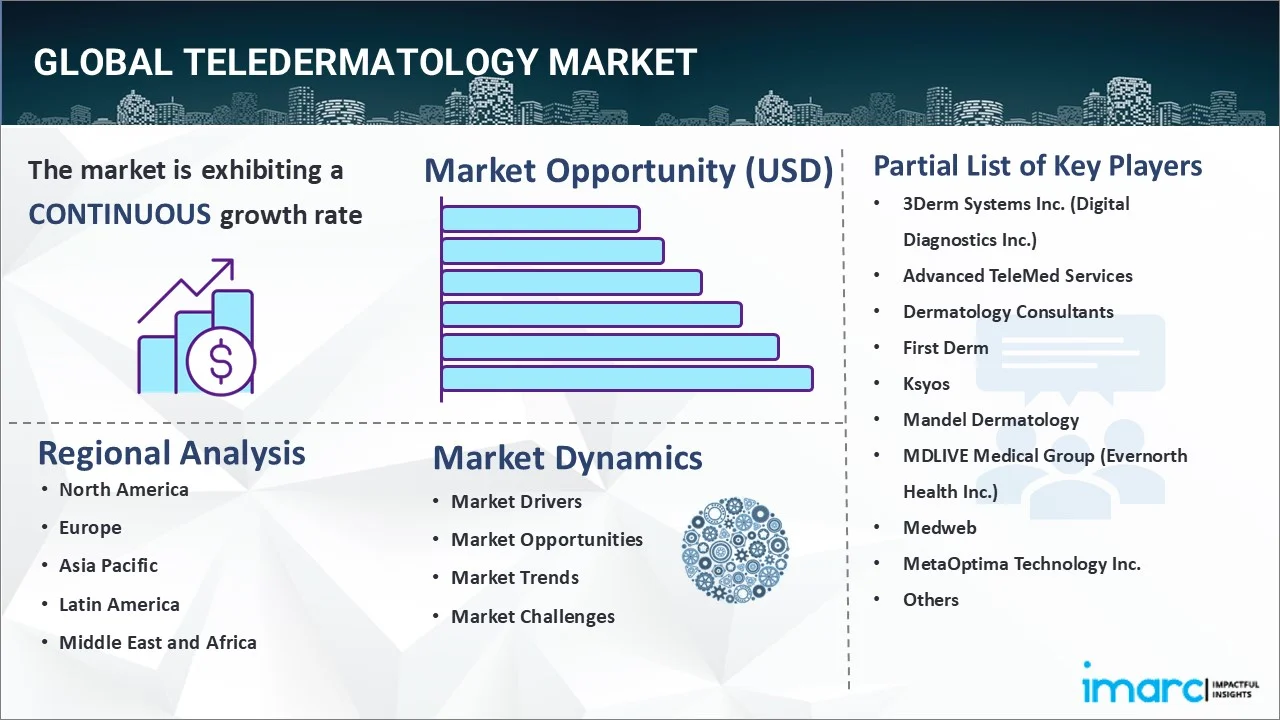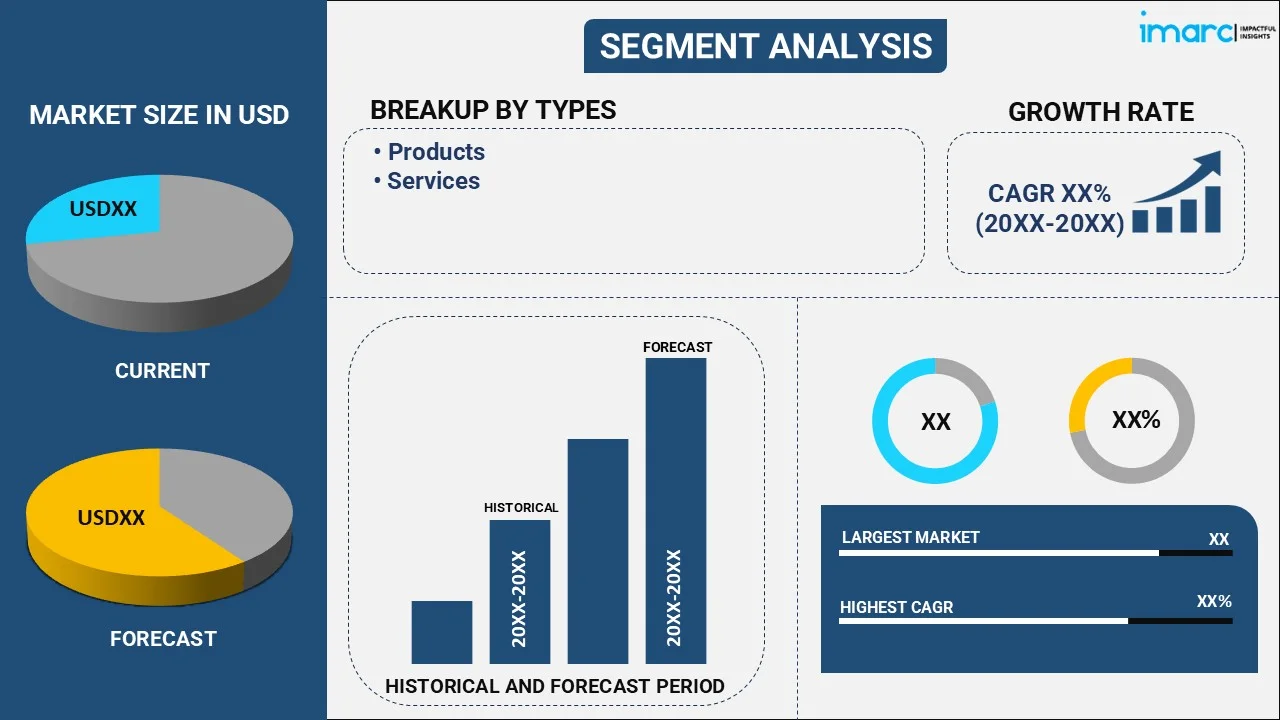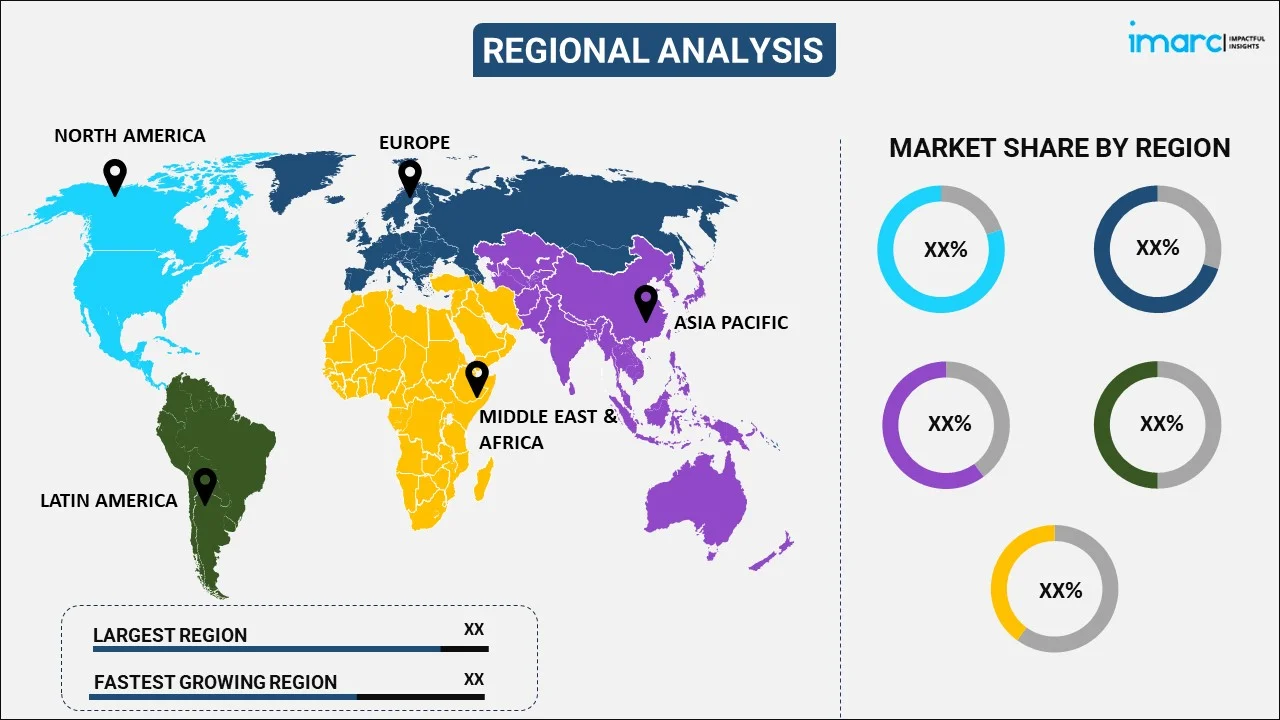
Teledermatology Market Report by Type (Products, Services), Modality (Store-and-Forward (Asynchronous), Real-Time (Synchronous)), End User (Healthcare Units, Homecare), and Region 2025-2033
Teledermatology Market Size:
The global teledermatology market size reached USD 12.1 Billion in 2024. Looking forward, IMARC Group expects the market to reach USD 47.8 Billion by 2033, exhibiting a growth rate (CAGR) of 14.82% during 2025-2033. The market is propelled by the increasing prevalence of skin diseases, significant advancements in telemedicine technology, growing awareness about remote healthcare, integration of AI in teledermatology, increasing mobile-app based consultations, and increasing collaborations between healthcare providers and telemedicine platforms.
|
Report Attribute
|
Key Statistics
|
|---|---|
|
Base Year
|
2024 |
|
Forecast Years
|
2025-2033
|
|
Historical Years
|
2019-2024
|
| Market Size in 2024 | USD 12.1 Billion |
| Market Forecast in 2033 | USD 47.8 Billion |
| Market Growth Rate (2025-2033) | 14.82% |
Teledermatology Market Analysis:
- Major Market Drivers: The increasing prevalence of skin diseases, significant advancements in telemedicine technology, increasing awareness about remote healthcare, and rising demand for economical dermatological care are some of the major market drivers.
- Key Market Trends: Some of the key market trends include the integration of AI in teledermatology, expansion of these services in rural areas, and growth of mobile-app based dermatology consultations.
- Geographical Trends: High adoption of enhanced healthcare technologies, favorable government initiatives and policies, and rising incidence of skin cancer and other dermatological conditions are factors escalating the North America teledermatology demand.
- Competitive Landscape: Some of the major market players in the teledermatology industry include 3Derm Systems Inc. (Digital Diagnostics Inc.), Advanced TeleMed Services, Dermatology Consultants, First Derm, Ksyos, Mandel Dermatology, MDLIVE Medical Group (Evernorth Health Inc.), Medweb, MetaOptima Technology Inc., Miiskin, Vesta Teleradiology, Zipnosis, among many others.
- Challenges and Opportunities: Some of the challenges include restricted access to high-speed internet in rural areas, increasing concerns about data privacy and security, and changes in reimbursement policies for telehealth services. Whereas, rapid expansion into untapped markets with healthcare needs, development of AI-driven diagnostic tools, and increasing partnerships between tech companies and healthcare providers are some of the teledermatology market recent opportunities.

Teledermatology Market Trends:
Increasing Prevalence of Skin Diseases
The global teledermatology market is significantly driven by the rising prevalence of skin diseases worldwide. Skin conditions such as acne, psoriasis, eczema, and skin cancer are becoming increasingly common due to various factors, including environmental pollution, changes in lifestyle, and genetic predispositions. According to the WORLD HEALTH ORGANIZATION (WHO), skin diseases affect almost 900 million individuals across the globe at any time. This growing burden of skin diseases necessitates effective and accessible dermatological care, which teledermatology can provide efficiently. Teledermatology allows patients to receive specialist care without the need for physical visits, making it particularly beneficial for individuals in remote or underserved areas. The convenience and accessibility of teledermatology services encourage more individuals to seek medical advice for skin conditions, leading to earlier diagnosis and treatment. This is crucial in managing chronic skin conditions and preventing complications.
Growing Awareness and Acceptance of Remote Healthcare
The increasing awareness and acceptance of remote healthcare services among patients and healthcare providers are creating a positive teledermatology market outlook. The COVID-19 pandemic has accelerated the adoption of telemedicine, including teledermatology, as individuals sought safe and convenient alternatives to in-person medical visits. According to a report by McKinsey, approximately 40% of individuals stated that they planned to continue using telehealth moving forward. This shift has led to a greater recognition of the benefits of teledermatology, such as reduced travel time, lower costs, and timely access to specialist care. Healthcare providers are also more inclined to integrate teledermatology into their practice due to its potential to enhance patient care and operational efficiency. Training programs and guidelines from professional organizations, such as the American Telemedicine Association (ATA) and the International Society of Teledermatology (ISTD), have further facilitated the adoption of teledermatology by ensuring that healthcare providers are equipped with the necessary skills and knowledge to deliver high-quality remote dermatological care, further positively contributing to the teledermatology market revenue.
Rising demand for Cost-Effective Dermatological Care
The increasing demand for cost-effective dermatological care is a significant factor leading to a teledermatology market growth. Traditional in-person dermatology consultations can be expensive, considering the costs associated with travel, appointment fees, and potential loss of income due to time off work. Teledermatology offers a more affordable alternative, enabling patients to receive expert care from the comfort of their homes. Teledermatology reduces the need for physical infrastructure and administrative support, allowing healthcare providers to offer services at a lower cost. This cost-effectiveness is particularly beneficial for patients without comprehensive health insurance or those in low-income regions. According to KFF analysis, the number of uninsured, nonelderly individuals reached 25.6 million in 2022, highlighting a substantial portion of the population that could benefit from more affordable healthcare options such as teledermatology. Moreover, teledermatology can lead to cost savings for healthcare systems by reducing the number of unnecessary in-person visits and optimizing the use of specialist time. For instance, primary care physicians can use teledermatology to obtain consultations for their patients without needing a referral to a specialist, streamlining the care process and minimizing delays, further creating a favorable teledermatology market overview.
Teledermatology Market Segmentation:
IMARC Group provides an analysis of the key trends in each segment of the market, along with forecasts at the global, regional, and country levels for 2025-2033. Our report has categorized the market based on type, modality, and end user.
Breakup by Type:

- Products
- Services
- Teleconsultation
- Telemonitoring
- Tele-Education
Services accounts for the majority of the market share
The report has provided a detailed breakup and analysis of the market based on the type. This includes products and services (teleconsultation, telemonitoring, and tele-education). According to the report, services represented the largest segment.
Services hold the largest teledermatology market share due to their essential role in providing direct patient care and consultations. These services include virtual consultations, follow-up appointments, remote diagnostics, and treatment plans, which are fundamental components of teledermatology. The accessibility and convenience of teledermatology services attract a broad patient base, particularly those in remote or underserved areas. Additionally, the ongoing advancements in telecommunication technologies and increasing patient awareness about telehealth benefits further bolster the demand for teledermatology services, making this segment the largest in the market.
Breakup by Modality:
- Store-and-Forward (Asynchronous)
- Real-Time (Synchronous)
Store and forward (asynchronous) holds the largest share of the industry
A detailed breakup and analysis of the market based on the modality have also been provided in the teledermatology market report. This includes store-and-forward (asynchronous) and real-time (synchronous). According to the report, store-and-forward (asynchronous) accounted for the largest market share.
Store-and-forward (asynchronous) teledermatology is the largest segment due to its convenience and efficiency. This method allows patients to send images and medical histories to dermatologists at any time, who can then review the information and provide diagnoses and treatment plans without the need for real-time interaction. This flexibility benefits both patients and providers by reducing scheduling conflicts and wait times. Additionally, asynchronous teledermatology is cost-effective, requiring less technological infrastructure than live video consultations, making it accessible to a broader population. Its ability to facilitate rapid, efficient care contributes to its dominance in the market.
Breakup by End User:
- Healthcare Units
- Homecare
Healthcare units represent the leading market segment
The report has provided a detailed breakup and analysis of the market based on the end user. This includes healthcare units and homecare. According to the report, healthcare units represented the largest segment.
Healthcare units are the largest segment in the market by end user due to their extensive infrastructure and resources, enabling them to integrate advanced teledermatology technologies effectively. They often have established networks, including specialist dermatologists and primary care providers, facilitating seamless teleconsultations. Additionally, teledermatology market recent developments, such as electronic health records (EHR) integration and high-resolution imaging systems, enhance the efficiency and accuracy of teledermatology services in these settings. These factors, coupled with the ability to manage large patient volumes and deliver comprehensive care, make healthcare units the predominant users of teledermatology solutions.
Breakup by Region:

- North America
- United States
- Canada
- Europe
- Germany
- France
- United Kingdom
- Italy
- Spain
- Others
- Asia Pacific
- China
- Japan
- India
- South Korea
- Australia
- Indonesia
- Others
- Latin America
- Brazil
- Mexico
- Others
- Middle East and Africa
North America leads the market, accounting for the largest teledermatology market share
The report has also provided a comprehensive analysis of all the major regional markets, which include North America (the United States and Canada); Europe (Germany, France, the United Kingdom, Italy, Spain, and others); Asia Pacific (China, Japan, India, South Korea, Australia, Indonesia, and others); Latin America (Brazil, Mexico, and others); and the Middle East and Africa. According to the report, North America was the largest regional market for teledermatology.
According to teledermatogy market forecast, North America is the largest segment in the teledermatology market by region due to region’s advanced healthcare infrastructure and high adoption rates of telemedicine technologies. The presence of major teledermatology service providers and robust regulatory frameworks further support market growth. Additionally, a high prevalence of skin diseases and strong insurance coverage for telehealth services drive demand. The impact of the COVID-19 pandemic has also accelerated the acceptance and utilization of teledermatology, solidifying the leading position of North America in the market.
Competitive Landscape:
- The market research report has also provided a comprehensive analysis of the competitive landscape in the market. Detailed profiles of all major companies have also been provided. Some of the major market players in the teledermatology industry include 3Derm Systems Inc. (Digital Diagnostics Inc.), Advanced TeleMed Services, Dermatology Consultants, First Derm, Ksyos, Mandel Dermatology, MDLIVE Medical Group (Evernorth Health Inc.), Medweb, MetaOptima Technology Inc., Miiskin, Vesta Teleradiology, Zipnosis.
(Please note that this is only a partial list of the key players, and the complete list is provided in the report.)
- Key players in the teledermatology market are driving growth through several strategic efforts. Teledermatology companies, such as DermTech, Teladoc Health and First Derm, are investing in advanced AI-driven diagnostic tools and high-resolution imaging technologies to enhance service quality. Partnerships with healthcare providers and expansion into underserved regions are increasing accessibility. Additionally, major players are engaging in awareness campaigns and educational initiatives to promote teledermatology benefits. Regulatory compliance and securing insurance coverage for teledermatology services are also prioritized, ensuring wider adoption. These concerted efforts by industry leaders are significantly contributing to the expansion and acceptance of the market.
Teledermatology Market News:
- August 27, 2023: THE INDIAN SOCIETY OF TELEDERMATOLOGY organized its 14th national conference, "Technology-enhanced Dermatology", which gathered 130 delegates. The detailed program included talks by Dr. Julia-Tatjana Maul on the evolution of treatment for psoriasis patients and perspectives of the global healthcare study on psoriasis, and Dr. Monisha Gupta on vitiligo treatment principles. The conference also received support from SPIN.
- May 2023: A new teledermatology service has been launched across the Black Country, allowing patients to receive faster triage and treatment for skin problems. The service, run by clinicians from four NHS Trusts, enables GPs to send images of skin conditions to dermatologists for quick feedback and guidance. More than 250 GP practices have signed up, covering a population of 1.5 million. The service aims to address the increase in skin cancer referrals and reduce the backlog by providing quicker care and access to diagnosis and treatment.
Teledermatology Market Report Scope:
| Report Features | Details |
|---|---|
| Base Year of the Analysis | 2024 |
| Historical Period | 2019-2024 |
| Forecast Period | 2025-2033 |
| Units | Billion USD |
| Scope of the Report | Exploration of Historical Trends and Market Outlook, Industry Catalysts and Challenges, Segment-Wise Historical and Future Market Assessment:
|
| Types Covered |
|
| Modalities Covered | Store-and-Forward (Asynchronous), Real-Time (Synchronous) |
| End Users Covered | Healthcare Units, Homecare |
| Regions Covered | Asia Pacific, Europe, North America, Latin America, Middle East and Africa |
| Countries Covered | United States, Canada, Germany, France, United Kingdom, Italy, Spain, China, Japan, India, South Korea, Australia, Indonesia, Brazil, Mexico |
| Companies Covered | 3Derm Systems Inc. (Digital Diagnostics Inc.), Advanced TeleMed Services, Dermatology Consultants, First Derm, Ksyos, Mandel Dermatology, MDLIVE Medical Group (Evernorth Health, Inc), Medweb, MetaOptima Technology Inc., Miiskin, Vesta Teleradiology, Zipnosis, etc |
| Customization Scope | 10% Free Customization |
| Post-Sale Analyst Support | 10-12 Weeks |
| Delivery Format | PDF and Excel through Email (We can also provide the editable version of the report in PPT/Word format on special request) |
Key Questions Answered in This Report:
- How has the global teledermatology market performed so far, and how will it perform in the coming years?
- What are the drivers, restraints, and opportunities in the global teledermatology market?
- What is the impact of each driver, restraint, and opportunity on the global teledermatology market?
- What are the key regional markets?
- Which countries represent the most attractive teledermatology market?
- What is the breakup of the market based on the type?
- Which is the most attractive type in the teledermatology market?
- What is the breakup of the market based on the modality?
- Which is the most attractive modality in the teledermatology market?
- What is the breakup of the market based on the end user?
- Which is the most attractive end user in the teledermatology market?
- What is the competitive structure of the market?
- Who are the key players/companies in the global teledermatology market?
Key Benefits for Stakeholders:
- IMARC’s industry report offers a comprehensive quantitative analysis of various market segments, historical and current market trends, market forecasts, and dynamics of the teledermatology market from 2019-2033.
- The research report provides the latest information on the market drivers, challenges, and opportunities in the global teledermatology market.
- The study maps the leading, as well as the fastest-growing, regional markets. It further enables stakeholders to identify the key country-level markets within each region.
- Porter's five forces analysis assists stakeholders in assessing the impact of new entrants, competitive rivalry, supplier power, buyer power, and the threat of substitution. It helps stakeholders to analyze the level of competition within the teledermatology industry and its attractiveness.
- The competitive landscape allows stakeholders to understand their competitive environment and provides insight into the current positions of key players in the market.
Need more help?
- Speak to our experienced analysts for insights on the current market scenarios.
- Include additional segments and countries to customize the report as per your requirement.
- Gain an unparalleled competitive advantage in your domain by understanding how to utilize the report and positively impacting your operations and revenue.
- For further assistance, please connect with our analysts.
 Request Customization
Request Customization
 Speak to an Analyst
Speak to an Analyst
 Request Brochure
Request Brochure
 Inquire Before Buying
Inquire Before Buying




.webp)




.webp)












